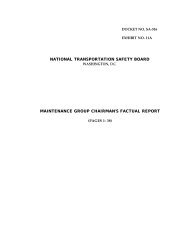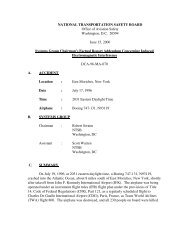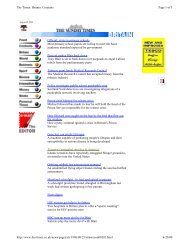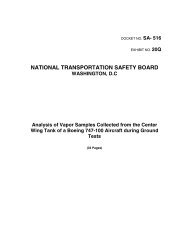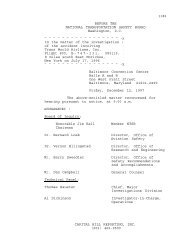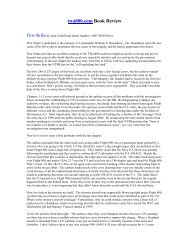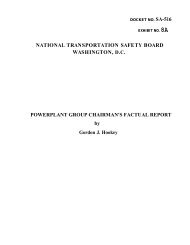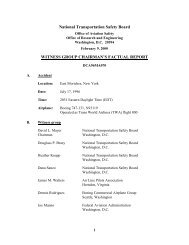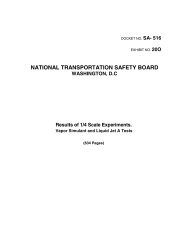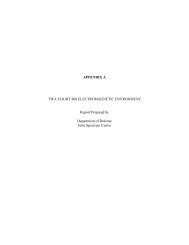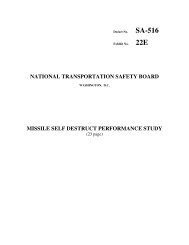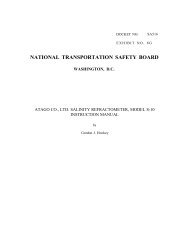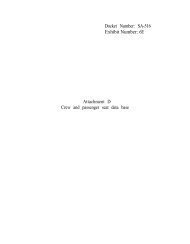Electrical Short Circuit/Arcing of Aged Aircraft Wiring
Electrical Short Circuit/Arcing of Aged Aircraft Wiring
Electrical Short Circuit/Arcing of Aged Aircraft Wiring
Create successful ePaper yourself
Turn your PDF publications into a flip-book with our unique Google optimized e-Paper software.
EXPERIMENTAL PROCEDURESWet Arc Tracking:The Wet Arc Tracking Test followed the SAE standard AS4373 4.5.9 method 509 testprocedures with certain deviations. In this test, a bundle <strong>of</strong> 7 wires (six around one) is suspendedhorizontally in a test chamber (Figure 3). The insulation on the top two wires (A1, B1) in thisbundle have been pre-damaged with circumferential cuts such that the conductor is clearlyvisible. The cuts are aligned so that they are separated by 6 mm.The bundle is connected to a 10 kVA, 3 phase, 400 Hz, 120 Vac line to neutral generatorusing the circuit shown in Figure 4. In this circuit, a 7.5 Amp circuit breaker and a 1 ohm resistor(simulating a long run <strong>of</strong> wire) are placed in series with each <strong>of</strong> the top 5 wires (A1, B1, C, A2,B2) which are called the active wires. The bottom two wires (D1, D2) are not connected to thegenerator (they are floating) and are called the passive wires.An Electrolytic solution is dripped on the wire such that the drop lands between the cutsin the insulation. In these tests two different electrolytes were used; A 1% by weight NaClsolution or lavatory waste water. The electrolyte was dripped at a rate <strong>of</strong> six drops per minute(100 mg/min) except in Test 1 when the rate was 10 drops/min.The experiment was allowed to run for 10 to 25 minutes or until a circuit breaker tripped.The circuit breakers were sometimes reset once or twice. After the test, the bundle was removedand a wet dielectric test was run on the 5 wires that were not pre-damaged (C, A2, B2, D1, D2).Shaving <strong>Short</strong> <strong>Circuit</strong>In this test a 7 wire bundle is used with two <strong>of</strong> the wires having circumferential cuts (~ 1mm wide) placed in the insulation so that the conductor is visible. These pre-damaged wires areplaced on opposite sides <strong>of</strong> the bundle and a metal shaving is woven through the bundle so thatin touches both <strong>of</strong> the exposed conductors. The bundle is suspended horizontally and the wiresare connected to the generator (see Figure 5). The experiment is started when the contactor isclosed and ends when a circuit breaker is tripped or the circuit opens due to evaporation <strong>of</strong> theshaving.Metal Shavings Abrasion TestMany different experimental setups were tried for the metal shavings abrasion tests withvarying results. Some created damage to the wire insulation and flashing events and others didnot. Two setups used are described here while others are described in Appendix B.90° (Right Angle) TestIn this test, one bundle <strong>of</strong> seven wires was used with a metal shaving, at least 0.5" long, woveninto the bundle. One end <strong>of</strong> the wire was secured to a stationary platform with a P-clamp whilethe other end was secured several inches away at 90 degrees from the direction <strong>of</strong> the first P-clamp, on an oscillating bar. The bundle had the form <strong>of</strong> a circular arc <strong>of</strong> about a 2" radius<strong>Electrical</strong> <strong>Arcing</strong> <strong>of</strong> <strong>Aged</strong> <strong>Aircraft</strong> Wire.Lectromechanical Design CompanyReport No. N191-RPT4AU99 August 12, 19993



